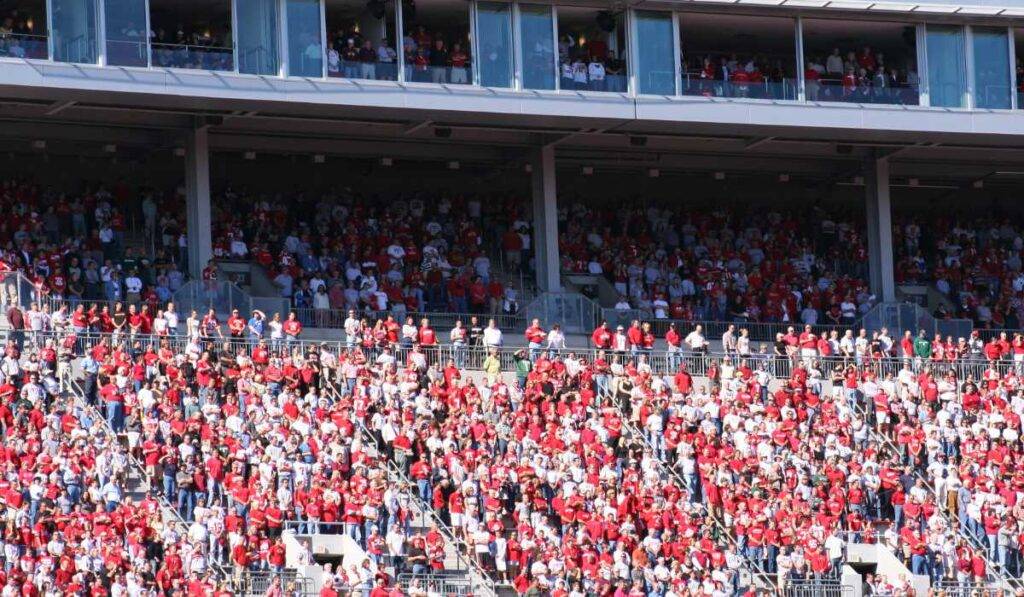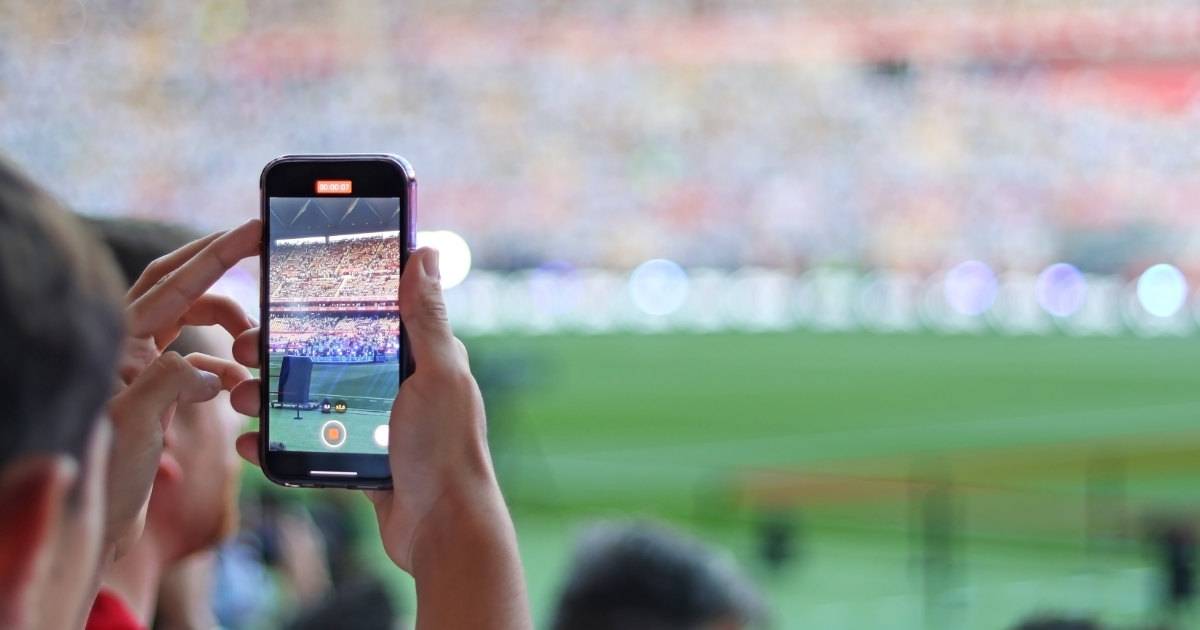Fans experience sports today on their channel of choice. And that choice is increasingly mobile in nature. In this age of always-on mobile platforms like social media and direct-to-consumer (DTC) apps, major sports leagues, teams and college conferences have evolved their content strategies.
They’re now focused on being round-the-clock, cross-channel storytellers to reach and engage sports enthusiasts beyond the traditional broadcast feeds. Live content capture programs in sports are quickly becoming a primary source to give today’s sports audiences the short-form digital media they most want. And importantly, they’re single-handedly generating new monetization streams for sports organizations everywhere.
Your athletes, clubs, internal departments and partners need to deliver a fast, steady stream of authentic live event experiences. These keep media-hungry audiences happy 24/7 and create more engagement and revenue. Short-form, mobile-captured content made for social and digital channels fills the bill. You can deliver easily digestible, immersive video and photo snippets that are fresh, in the moment, and make fans feel like they’re in the stands.
Sports organizations have become media powerhouses to fill this continuous cry for original content across channels. The amount of short-form digital media they need can quickly overwhelm even the largest and most sophisticated sports content operations.
To take on these challenges, sports organizations are building live content capture programs. They’re doing it with the help of dedicated live content creators and technology.
Read on to learn more about live content capture programs in pro and college sports. And get seven of the best practices we’ve uncovered working with and gleaning insights from many of the top sports digital teams that run these programs worldwide.
Live Content Capture Programs in Sports: 7 Lessons for Success
With live content capture programs, organizations have designated correspondents at every event throughout the season and year. These creators focus on shooting candid, behind-the-scenes photos and videos on their mobile phones or DSLR cameras. They can get the up-close, live atmosphere views that broadcast footage or field-side pro photographers focused on game action can’t.
Once captured, the creators’ photo and video content is automatically imported, curated and distributed through AI-powered technology across the organizations’ networks of broadcasters, sponsors, staff, athletes and other stakeholders. They — and their fans — get it immediately while games are still in progress. This content feeds digital and social channels, DTC mobile apps, linear broadcast segments, sponsor programs and more.
Building a successful live content capture program with these contributors and technology can catapult outcomes for clubs and leagues everywhere. But it takes some know-how to set up and successfully sustain such an initiative.
1) Select Live Content Creators With Care
All-access content captured by your correspondents won’t look the same as what standard photographers and videographers pick up at events. The raw perspectives collected around the venue on mobile devices and DSLR cameras typically aren’t as polished. But they tend to perform better on social media with fans. So, it’s imperative that you choose creators who understand how to capture these moments that resonate with social audiences — and can do it quickly.
Look for correspondents whose work showcases their expertise in crafting stories with a unique lens toward social platforms that your fans use. Lean into talent who excel at how various formats and channel environments stack up with your audiences. Content teams we work with also cite the importance of hiring creators who are passionate about their particular organization and sport. They have knowledge of the game rules and how those events flow.
Some live content creator selection tips from top sports league LCC program managers:
- Think about how many live content creators you may need at each of your games and in each of your markets.
- Get recommendations from industry peers.
- Review their online portfolios for style and creative approach.
- Verify their technical skills (e.g., content capture and editing) and knowledge of your sport.
- Choose correspondents who can troubleshoot in the moment without direction, meet deadlines, and provide timely updates.
- Confirm what equipment they have and can use, like DSLR cameras with accessories or mobile phones with advanced features.
- Select creators who can positively represent your organization as they interact with various stakeholders. These could include fans, staff, athletes and celebrities, partners and more.
“The content we’re looking for is social content. …It’s a different eye that we’re looking for in telling a story on social, and their content is different from a traditional photographer’s.
We’re looking for someone who really understands how to tell these stories for us and they know how to get it quickly and they understand the value of social.”
– Nicole Caporaso, Manager, Social Media Programs, NHL, speaking at the 2024 Gondola Sports Summit
2) Build Support and Relationships From the Start
It’s critical to select the right correspondents. But you also need to set them and your overall program up for success.
Gain buy-in and trust from key program stakeholders up front as you consider the scope and budget needed. You’ll want your execs to understand and champion how a robust short-form live content capture program using creators and technology benefits the entire organization. This includes your broadcast partners and corporate sponsors (who could help underwrite the costs). Also, you’ll want your athletes to see how much value building their personal brands through this content on social channels offers.
Some to-do list items:
- Audit your existing gameday content strategy and operations. Understand where your content bottlenecks are and where improvements could be made. These could be any complex methods used to move media files throughout your organization via email or Slack. Or they could include the time it takes to manually tag assets.
- Set goals and KPIs for what you want to get out of a content capture program and review them consistently. Do you want to collect hundreds of assets to fill particular channels or give to sponsors or broadcast partners each week? Or perhaps you aim to get 90% of your players sharing the captured content.
- Consider establishing a pilot program to test how it could fit into your existing content processes and tech workflows. You can learn how scaling such a program could work as you contemplate adding more people and resources.
- If you’re at the league level, make sure your clubs know about the program and get behind integrating it into their content infrastructures.
- If you’re at the club level, ensure your staff across the organization is aware of the program. We see short-form media captured through these programs used in every department. That includes teams from ticket sales and PR to sponsorship and fan development.
- Introduce your correspondents to your club personnel, athletes, coaches, security staff and other venue teams so everyone starts to recognize names and faces. Share that these creators will need access to people and venue areas to accomplish their tasks and facilitate getting content routed promptly.
- Pair new correspondents with your PR or social team or existing correspondents for training and shadowing before they go out on their own.
3) Provide Direction, But Let Your Creators Shine
You’re filling your live content capture program with creators who can put their unique spin on your live events. You’ll want to balance giving them enough guidance on the content you need to meet your goals but enough room to personally interpret and capture what’s happening in the moment.
Some tips to create that balance:
- Have detailed shot lists of what you want captured ready for your live content creators at each event. And let them add in more beyond those minimum requirements as time allows. With tech like Greenfly, you can even make specific content requests to your creators. You can include detailed instructions and designate content formats, orientation and other attributes you want. For example, you may want footage of a star rookie for a feature or hype video.
- Consider the formats and channels your particular fans engage most with and prioritize those for creators (e.g., vertical video for TikTok).
- Ask them to capture different angles around the venue. But understand ahead of time what areas your correspondents will have access to within each venue to plan with them accordingly. You may find a visiting arena offers less (or more) access to areas like the locker rooms or broadcast booths than your home arena.

4) Prioritize Continued Communication
Your program can be made or broken depending on how consistently and comprehensively you communicate with your team and live content creators.
Some items for your comms checklist:
- Set up streamlined communications and detailed processes for your correspondents and team to reduce the ambiguity of tasks.
- Decide on the shared content tools you and your creators will use. These could be a cloud database, project management software or spreadsheets. Many teams prefer a centralized platform and app like Greenfly, where creator content can be automatically captured, organized, discussed (by groups or individually) and distributed to streamline the entire process.
- Bring your creators into your strategies. Giving them context on why you want particular content helps them make better on-the-spot decisions and find more captivating angles.
- Determine if you have enough creator coverage at each game and across multiple events or sports to capture the content you want. Communicate schedule updates to correspondents accordingly.
- Keep your live content creators up to speed each game. Let them know about any special guests attending, athlete arrival times or significant milestones (club or athlete) that may be happening. They can think ahead about their best positions to capture what may be once-in-a-lifetime moments.
- Offer regular constructive feedback on the content they submit. Messaging and broadcast communication features within content workflow software like Greenfly help facilitate conversations. You can answer time-sensitive creator questions, deliver bulk greetings and provide quick feedback.
5) Curate and Distribute in the Moment
Live content capture programs in sports thrive with technology that becomes part of your short-form content infrastructure. You can get real-time delivery when your content is at peak relevancy for all your stakeholders and fans. Advanced technology can allow users to do even more with content organization and distribution, so stakeholders get curated content from creators to fans immediately.
This live creator content capturing behind-the-scenes moments has become a new asset class in sports. And with it in hand to distribute immediately and broadly, sports organizations can build more revenue through unique and authentic sponsorship experiences, larger media rights deals, and exclusive fan offerings. At Greenfly, we’re seeing some major sports leagues generating multi-million dollar returns just through their live content capture programs.
As one example of live correspondent content curation and distribution, DFL Deutsche Fußball Liga, the governing body of the top football league in Germany, the Bundesliga, recalibrated its sports media operations a few years ago. The DFL team established the innovative ‘Social Media Matchday Feed’ powered by Greenfly. The DFL digital team and every club’s dedicated social media reporter create exclusive and authentic in-stadium content before, during and after every match. Bundesliga distributes it seamlessly in real time to the 36 Bundesliga clubs. And they distribute it to over 60 international media partners, who deliver it to fans everywhere.
The National Hockey League (NHL)’s Live Social Contributor (LSC) Program across the league’s 32 Clubs brings the excitement of every NHL hockey game and tentpole event to life for passionate fans globally. Greenfly +AI Vision manages the real-time automated analysis and tagging of large volumes of digital videos and photos. With it, hundreds of LSC videos and photos now make their way from the ice to fans more quickly every NHL Game Day and Night.
“Every second counts within the NHL’s Live Social Contributor Program. Fans want their content fast.
Greenfly’s artificial intelligence tagging features make it possible to route thousands of photos and videos shot by LSCs across 32 arenas directly to the athletes, Clubs, and broadcast partners who want to publish them in real-time.”
— Heidi Browning, Chief Marketing Officer, NHL
Some tips for content curation and delivery:
- Use the shot lists you’ve created above to build tags and organize the content you expect to receive for each game.
- Set up specific game or team asset galleries (decide on a strategy or do both). And create folders or galleries for particular game elements (e.g., pre-game ceremony), special players (e.g., Korean players for Korean broadcasters) and more.
- Don’t stop with giving content to your athletes for their social channels. Route it to coaches and staff and across your internal departments. Everyone in your organization wants a piece of this creator content gold in real time.
- Send this media to your corporate sponsors. Creator content with brand logos shown on venue signage, jerseys and equipment can be identified, tagged and routed to these partners. They can use them for their marketing channels, adding value to your relationship and spurring more of their investment in your property.
- Give your worldwide broadcast partners content for their cross-platform channels. This content can be curated by the market, club, event and more to drive tune-in.
- Encourage your correspondents to share their captured content on their social channels to broaden your footprint even further.
6) Measure Your Live Content Capture Program
Live content capture programs with correspondents and technology have transformed content strategies across sports organizations. It’s critical, however, to continually monitor your program outputs for effectiveness and improvements through your technology platform and social channel reports.
Some elements to regularly analyze:
- Asset utilization rate: Which content is getting used, whether that’s based on the creator, the game, the content type or ‘scene,’ or more?
- User engagement: Which recipients are or are not using content at all and with or without high frequency?
- Content preference: What can you learn from content that is used at a high rate or getting viewed but NOT used?
- Creator success: Are some creators getting their content used at a higher rate than others? What lessons can you take from that?
- Benchmarks: What does an average week look like for content production, content utilization, gallery size, and video or image ratio?
- Engagement: How are particular pieces of content performing on your social channels (or other platforms used)?
7) Maintain Program Momentum
To keep your program running smoothly, prioritize regularly engaging with participants and users to optimize outcomes.
Some best practices to sustain your live content creator program:
- Survey your creators and end users regularly. Understand what improvements in creative approaches and processes can make their jobs easier when sourcing content. And learn how your internal teams and other stakeholders use the collected content.
- Reward correspondents for stellar work and content performance.
- Offer regular group and individual review sessions to share feedback, best practices and tips on new creative approaches.
- Create an ongoing forum to build a community where creators can also learn and interact with each other, and your team can recognize their efforts collectively.
- Give your live content creators more visibility to enhance their careers. Many of your correspondents likely want to pursue careers in this area and even within your organization. So, support their goals and give them more chances to shine and network with peers.
How Greenfly Helps Optimize Live Content Creator Programs
“Greenfly is a massive part of our content operation. The ease and timeliness in which our players, clubs and league accounts get content has been an absolute game changer. We employ more than 60 photographers / videographers, and Greenfly is the connective tissue between all of them. It makes content creation so much easier for us.
Greenfly saves our team(s) so much time. Fast upload speeds are crucial with 15 games every night, and being able to house all the content in one space is so clutch for us.”
— Sports League Partner
Greenfly is the short-form content infrastructure underpinning many sports content programs worldwide for content collection, organization and distribution. And we’ve specifically built a workflow for live content capture.
With it, you can create and clone shortcuts before an event to pre-select the destination for captured creator content (e.g., a specific asset gallery or team or event channel). You can also automatically apply tags and descriptions when uploading through these shortcuts. This capability offers a huge bulk media asset time-saver for mobile content creators. And it ensures the live content you receive remains organized and tagged.
Greenfly +AI Vision also helps eliminate manual organization and curation for creator-captured videos and photos. With its scene detection model, +AI Vision can automatically identify athletes, teams and brand logos. It can also identify and describe any type of core scenes your creators may pick up. This could include player arrivals, sidelines, fan reactions and more. You can search this content anytime for specific tags like “celebration” or “arrival” to speed up your processes.
Contact us at Greenfly to learn more about how we can help you with live content capture programs.

